home
der Film
Inhalt
Meinungen
Verleih
Download
Credits
Trailer
Impressum
Filmografie
L.Mangelsdorff
Behind Music: An appreciation of Lilo Mangelsdorff’s film “Donkey, Dog, Cat and Cock” by Angela Mailander, Ph.D. Lilo Mangelsdorff’s new film, “Donkey, Dog, Cat and Cock” is ostensibly a documentary about music making in the lives of ordinary and not so ordinary people. But calling her film merely a documentary would miss its artistry and its rich layering of emotional complexity: it is heartbreaking, funny, tragic, and full of life and hope and courage while also being a insightful portrait of contemporary German life. In fact, this portrait has a poetic quality with an underpinning of philosophical depth and significant insight into human psychology. The title of the film comes, of course, from Grimm’s fairy tale, “The Town Musicians of Bremen,” in which the four animals of the film’s title,finding themselves too old to serve their masters and therefore threatened with imminent death, band together with the intention of traveling to Bremen where they hope to become “town musicians” because “You can find something better than death anywhere.” |
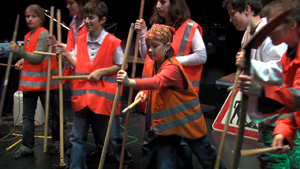 |
|
The film is held together by intermittent scenes of the children of Grade 2b of the Günderrode School taking turns reading that story out loud, thus providing both a refrain and a unifying metaphor, as the animals in the story stand for all musicians and all those who, through music, wish to find something better than death in any situation. In one group of musicians discussing the story, a member makes this connection explicit when he says of the animals, “They were almost…they were at least as culturally diverse as we are.” Banding together, or a sense of community, is an important theme of this film. One of the musicians says of the animals, “And they realized somehow that they’d all win if they got together.” Again and again in the film we hear that people appreciate the sense of community that comes from belonging to a music group. One initially reluctant drummer says, “But what got me going was the community spirit I found here.” And another one comments, “That’s an important part, to find a community.” But there is more to it than just the sense of belonging. A young musician explains: It’s the group. You know, you’re only part of the whole thing, like part of a chord—you can only sing one note at a time, and the music makes it so you can put different chords together, so you are what makes the others complete and they complete you. That’s in total contrast to the world of work where everybody goes for self—so that’s kind of beautiful that of our own free will we joyfully unite for something better.” On the other hand, a middle-aged professor (who is taking beginner’s clarinet lessons) comments, “Behind music making, behind such uselessness—and this is true for…all the arts—there really is a utopia. Something that’s not lived.” Is it really not lived? The film ends with the “Art Salon Orchestra” under the direction of “Klaus, the fiddler,” performing “Youkali,” a tango whose lyrics we don’t hear in the film, but a few lines from it are worth quoting (in my translation from the original French): |
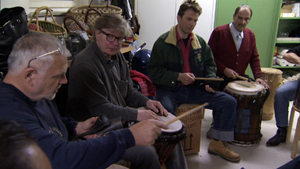 |
|
Tango Habanera Almost at our world’s end, Our vagabond ships wend Their way. They’re landward bent Youkali Delivering us one day To an island unseen, But its Elvin queen Invites us, lovely as a dream, To risk the foray. Youkali, it’s the land of our desire Youkali, it’s our fortune and pleasure, Youkali, where we forget our deep sorrow. In our darkest night, It is the clear light Of the star bright Youkali we follow! |
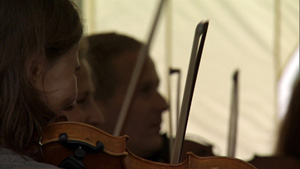 |
|
That is the first stanza. At the end of the second stanza, however, we hear: But it is only a dream, and a folly There’s no such place as Youkali! With that song ending the film, it would seem that the filmmaker is of the same opinion as Professor Dost that behind art there is a utopia that is not lived.And it seems, too, that this is the import of Grimm’s fairy tale: The animals in the story never arrive in Bremen and never become the town’s musicians. But a denial of the reality of “Youkali” would be a one-sided interpretation of the film, as Mangelsdorff is an artist, not a polemicist. To counterbalance Professor Dost’s position, there is also the scene in the nursing home, where an old woman spontaneously recites song lyrics she has learned in school many decades ago (the translation from the German is mine): And suddenly the nightingale Begins her lovely song. The sound awakens hill and vale Clear, the echoes upward throng, Dawn’s colors join and sing, Sound and light on wedded wing— Praise the Lord with voices strong. |
 |
|
The possible existence of “the Lord” suggests that the longing expressed in the song Youkali is answered in the promise of all religions. We can understand “God” and “The Lord” to signify “something greater than ourselves.” An article in the New York Times earlier this year offered a summary of what the Western science of Psychology has actually managed to learn in the roughly one hundred years of its existence. Accompanying the article is a cartoon that shows a circus monkey riding a tiger. And the caption tells us that the monkey thinks he’s in charge. It is as clear an image as we could wish of the dual nature of man, in which the monkey stands for what we are normally pleased to call “self” and the tiger is a metaphor for “something greater than” that small and bounded conception of self. Western psychology has studied the monkey pretty exhaustively, but it knows next to nothing as yet about that tiger, as there is no agreement in the scientific community as to its reality status, its nature, its attributes, its boundaries, or even if it has boundaries. There are, of course, all kinds of ancient traditions that purport to know all there is to know about our Lord the Tiger or Youkali or any number of other metaphors standing for that largely unknown aspect of ourselves; but many of us would prefer knowledge more direct than the hear-say of tradition, however venerable. It is, in fact, for this reason that many of those traditions recommend some praxis designed to bring about that experience. As a practitioner of meditation for more than sixty years, as a practicing artist (poetry and painting), as a member (until recently) of a drum circle, and as a practitioner of Tai Chi, I would say that meditation and the practice of any art or craft or sport will eventually yield the same living experience—something greater than ourselves where “self” signifies the “circus monkey” and the “tiger” signifies that something greater beyond it. |
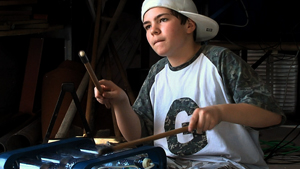 |
|
As the holder of a couple of Ph.D.’s in philosophy and literary studies, however, I also have to say that Professor Dost’s position is certainly tenable, though with one important modification: “Behind music making, behind such uselessness — and this is true for…all the arts—there really is a utopia. Something that I have never lived.” He cannot generalize it to “Something that is not lived.” I have never understood the tendency of intellectuals to assume that their experience is commensurate with that of all mankind, but the tendency is deep-seated and of very long standing in the Western philosophical tradition. It is certainly the case that the tiger beyond the circus monkey is also beyond the intellect where most professors chiefly live it seems. Writers have often described their process as “taking dictation.” Artists speak of “getting out of the way” so that art can happen. In the film, the voice student Dr. Peppler explains, “The thing about singing is to relax. Then your voice does its thing just fine. And the rest happens more or less on its own too.” |
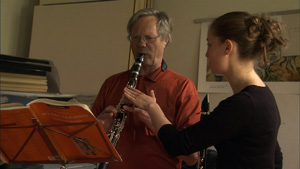 |
|
A clear demonstration of such relaxing and such getting out of the way in Mangeldoff’s film can be seen in Christiane, a singer in Alessandro Palmitessa’s “Human Symphony Orchestra.” She is the young woman who miss-hears the word “legato” as “elegant,” and then, realizing her mistake, comments with self-irony, “I’m just a bag lady”. Her kind of music may not be our cup of tea, but when we look at her sing and really listen, it is obvious that she is no performing circus monkey, but that, instead, the tiger is singing through her.She is very much living that reality as she sings, and is more intensely alive than she is when not making music. Once we have the eyes to see and the ears to hear the tiger, we can see it also in the old woman’s completely unselfconscious recitation of the lyrics quoted above. For her, there is no need for a euphonious voice or a more “professional” presentation. Where the professor in me would complain about the out-dated Romantic diction and imagery of the poem and it’s use of “the Lord” in the last line, the human being and the artist in me recognizes that for the old woman, who is close to death, those words are alive as, for her, there is no distinction between name and form. To me, that scene is the center of Lilo Mangelsdorff’s film—not only does it stand at the real-time center of the movie, it encapsulates the whole in seed form and, as such, it is implicit in every scene of the film. Like the whole movie, that scene is heartbreaking, funny, tragic, and full of life and hope and courage. And the poem comes as close as can be to naming that which is behind music in its deepest sense, a sense in which the birth of light and the birth of sound are one. |
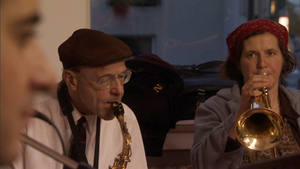 |
|
The last “word” in the film, after all, is not the tango “Youkali.” Instead, it is the camera traveling upwards into the leaves of trees and the sky beyond them, a metaphor of distinction (the leaves) and that which is beyond distinction (the sky). Is this upward movement an image of the echoes as they “throng” upwards? The film begins with the sound of bird song and rain in the leaves of trees. It is a fact that bird song opens the pores (stomata) of leaves so that they can absorb the nutrients in dew or rain. Does music open our small and bounded sense of self of something greater? Whatever the answer, translating the voice transcript of Mangelsdorff’s film and seeing it many times, my best praise of it is to repeat the words of the child who, while putting his hand on the cello to feel its vibration, closes his eyes in an innocent and profound act of being able to hear better and then comments, “It was alive.” Kommentare der mitwirkenden Schulklasse zur Filmvorführung |
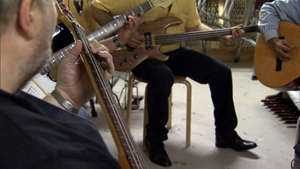 |
|